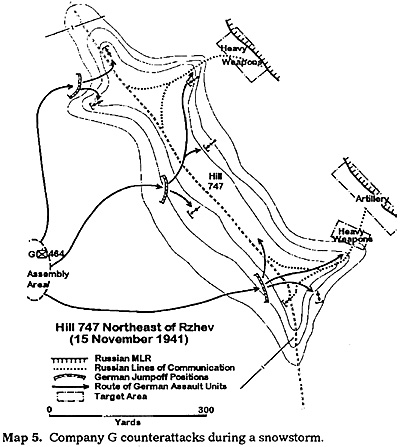 This action is typical of the fighting in the late autumn of 1941, when Russian resistance began to stiffen west of Moscow and the ill-equipped German troops had to rally all their energy to continue the advance toward the Russian capital.
This action is typical of the fighting in the late autumn of 1941, when Russian resistance began to stiffen west of Moscow and the ill-equipped German troops had to rally all their energy to continue the advance toward the Russian capital.
In November 1941, the 464th Infantry Regiment of the German 253d Infantry Division was occupying field fortifications about 60 miles northeast of Rzhev. On the regiment's right flank was Hill 747 (see Map 5). Since the hill afforded an extensive view of the German rear area, the Russians had made repeated attempts to capture it in an effort to undermine the position of the 464th Infantry Regiment. The hill had changed hands several times, but was now occupied by the-Germans. The presence of heavy weapons including assault guns, as well as reports of repeated reconnaissance thrusts, gave rise to the belief that the Russians were preparing for another attack against the hill. Accordingly, the regimental commander withdrew Company G from the sector it was holding and committed it on the regiment's right flank.
After reporting to battalion headquarters around noon on 15 November, Lieutenant Viehmann, the commander of Company G, accompanied by his platoon leaders, undertook a terrain reconnaissance. A heavy snowfall set in. As the group was returning from the reconnaissance mission, submachine gun and mortar fire was heard from the direction of Hill 747. The company commander attached little importance to this at the time. However, upon arriving at the battalion CP he learned that the Russians had taken advantage of the snowstorm and had seized the hill without artillery or mortar support in a surprise raid. An immediate counterattack by German troops failed to dislodge the Russians.
Viehmann thereupon received orders to recapture the hill in a surprise attack to be launched at 2200. Regimental headquarters attached a medium mortar platoon and a light howitzer platoon to the company and promised artillery support. Viehmann formed three assault parties and moved them into jump off positions close to the Russian line under cover of darkness. The infantry company to the right was to divert the attention of the defending force at the time of the actual attack, while the unit to the left was to support the attack with is fire. Artillery and heavy weapons were to open fire on specified area at prearranged flare signals.
The German assault parties occupied their jumpoff positions without attracting the attention of the defending Russians. The party in the center, led by Viehmann, was only about 35 yards from the nearest Russian position. Close observation of the Russian defenses and the actions of individual soldiers indicated that a German attack was not anticipated. The Russian sentries were shivering from the cold and were by no means alert. Rations and supplies were being drawn. Not far from Viehmanns oberservation point a Russian detail was unloading furs and felt boots from a sled.
More Company G
-
Introduction
Company G Counterattacks During a Snowstorm (November 1941)
Company G Operates in Deep Snow (January 1942)
Russian Infantry Attacks a German-Held Town (January 1942)
Company G Struggles Against Overwhelming Odds (March 1942)
Company G Annihilates a Russian Elite Unit (March 1942)
Back to Table of Contents -- Combat Simulation Vol 1 No. 1
Back to Combat Simulation List of Issues
Back to MagWeb Magazine List
© Copyright 1994 by Mike Vogell and Phoenix Military Simulations.
This article appears in MagWeb (Magazine Web) on the Internet World Wide Web.
Other military history articles and gaming articles are available at http://www.magweb.com